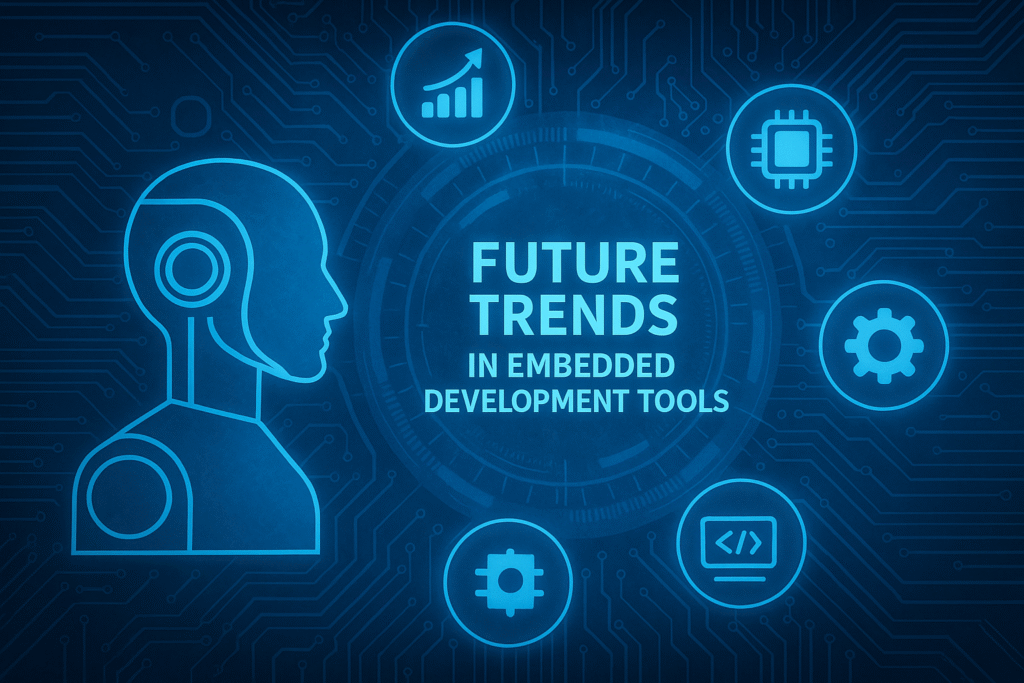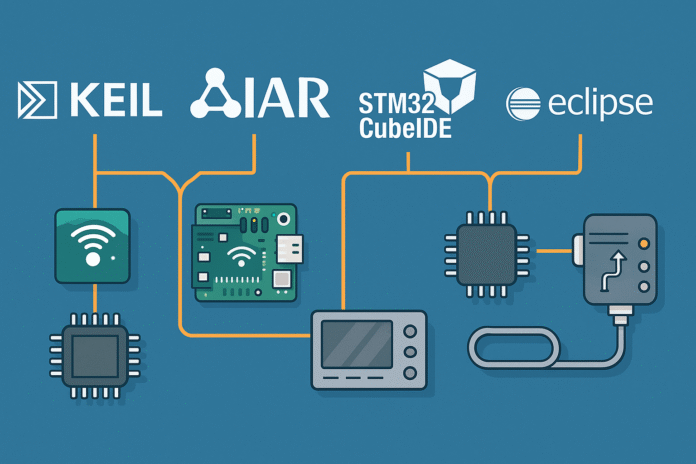Understanding the top development tools and IDEs for embedded programming is critical for engineers, programmers, and organizations working with embedded systems. Embedded development combines both hardware and software, requiring precision, efficiency, and long-term reliability. Successful projects depend on the right development environment, debugging hardware, and simulation platforms, alongside careful pcb design to ensure smooth integration between software and electronics. This article provides a detailed guide to the most widely used tools, IDEs, and support systems for embedded programming, with insights into how they support the development cycle from design to deployment.
Overview of Tool Categories
Embedded development requires specialized tools to handle unique hardware and software constraints. These categories form the foundation of the embedded engineering toolbox:
- Integrated Development Environments (IDEs): Provide editors, compilers, and debugging capabilities in one platform.
- Simulators and Emulators: Model hardware behavior before hardware is available.
- Compilers and toolchains: Translate source code into optimized machine code for target hardware.
- Hardware debuggers (JTAG/SWD): Allow step-by-step debugging on real devices.
- Source control and collaboration tools: Manage code and version history across teams.
- Performance analyzers: Detect bottlenecks and optimize power usage.
Each tool serves a distinct role in creating reliable, efficient embedded applications.
Popular IDEs
Keil MDK (Microcontroller Development Kit)
One of the most established IDEs for ARM-based microcontrollers.
- Features: Optimizing compiler, RTOS support, extensive debug features.
- Use cases: Industrial automation, automotive ECUs, and low-power MCUs.
IAR Embedded Workbench
Widely known for producing highly optimized code.
- Strengths: Cross-platform support for multiple architectures, strong debugging tools, code analysis.
- Industries: Aerospace, defense, and safety-critical devices requiring high reliability.
MPLAB X IDE
Developed by Microchip for PIC, dsPIC, and AVR devices.
- Advantages: Free-to-use, integrated with Microchip hardware tools.
- Applications: Entry-level microcontroller designs, educational labs, and IoT devices.
STM32CubeIDE
Developed by STMicroelectronics for STM32 MCUs.
- Features: Graphical configuration tools, code generation wizards, integration with HAL libraries.
- Best for: Engineers using STM32 boards in consumer electronics and IoT projects.
Eclipse with CDT and Embedded Plugins
Open-source IDE widely adopted across industries.
- Pros: Highly customizable, supports multiple toolchains.
- Cons: Requires setup and tuning compared to vendor-specific IDEs.
- Use case: Teams needing flexible workflows across various microcontroller families.
These IDEs form the backbone of daily embedded programming work, offering environments that simplify coding, debugging, and testing.
Simulators and Emulators
Simulation and emulation tools allow development to proceed before final hardware is available.
QEMU (Quick Emulator)
- Open-source tool capable of emulating multiple processor architectures.
- Supports Linux-based embedded development.
- Used for prototyping and system testing.
Proteus Design Suite
- Combines circuit simulation with MCU emulation.
- Ideal for education and prototyping embedded projects.
- Integrates both software and pcb design testing.
Renesas e² studio simulator
- Provides simulation for Renesas microcontrollers.
- Helps engineers test logic before moving to actual hardware.
By leveraging simulation, engineers reduce risk and accelerate development timelines.
Hardware Debuggers and JTAG/SWD Tools
Debugging hardware is indispensable for real-world testing. These tools connect to MCUs and allow step-by-step execution, memory inspection, and performance monitoring.
JTAG Debuggers
- Industry standard for embedded debugging.
- Supports boundary scan testing and deep visibility.
SWD (Serial Wire Debug)
- ARM-specific protocol offering two-pin debugging.
- Used in low-pin-count, resource-constrained devices.
Segger J-Link
- Widely supported commercial JTAG/SWD debugger.
- Fast, reliable, and compatible with multiple IDEs.
ST-LINK
- Low-cost debugger for STM32 microcontrollers.
- Integrated with STM32CubeIDE and STM32CubeProgrammer.
Microchip PICkit
- Affordable debugger/programmer for PIC and AVR MCUs.
- Useful for educational labs and entry-level projects.
These tools ensure developers can trace issues at the hardware level, improving code reliability and speeding up troubleshooting.
Compilers and Toolchains
Embedded systems depend on efficient compilers that produce optimized machine code.
- GCC (GNU Compiler Collection): Widely used in open-source embedded toolchains.
- Clang/LLVM: Gaining adoption due to modular design and modern optimizations.
- ARM Compiler: Optimized for ARM-based microcontrollers.
- IAR Compiler: Known for producing the most compact and efficient code.
Toolchains often integrate with IDEs to streamline the workflow from source code to binary deployment.
Source Control and Collaboration Tools
Collaborative development is as important in embedded systems as in general software.
- Git and GitHub/GitLab: Manage codebases and facilitate team collaboration.
- Bitbucket: Popular in enterprise projects with integration to project management tools.
- Perforce: Used in large-scale projects with strict version control needs.
Version control ensures changes are traceable, bugs can be isolated, and teams stay aligned.
Performance Analyzers and Profiling Tools
Optimizing performance is critical due to limited resources in embedded systems.
- Tracealyzer: Visualizes RTOS execution for FreeRTOS, Micrium, and others.
- ARM Streamline: Helps analyze CPU, GPU, and memory usage in ARM-based systems.
- Valgrind: Used in Linux-based embedded systems for memory debugging and profiling.
These tools help engineers meet real-time constraints while reducing power consumption.
How PCB Design Interacts with Embedded Development Tools
Embedded programming success depends not only on software but also on hardware alignment. Strong pcb design supports software by:
- Providing proper grounding and signal routing for stable firmware performance.
- Ensuring power regulation that allows software to run reliably.
- Including debugging headers for JTAG/SWD tools.
- Designing for testability with accessible test points.
Good PCB practices enhance debugging, reduce failures, and simplify programming workflows.
Real-World Case Applications
Automotive ECU Development
- Tools: IAR Embedded Workbench, Segger J-Link.
- Requirement: Real-time debugging and safety-critical compliance.
IoT Device Prototype
- Tools: STM32CubeIDE, Proteus simulator.
- Integration: Quick prototyping and power analysis.
Aerospace Avionics System
- Tools: Keil MDK, Tracealyzer, ARM Compiler.
- Requirement: Reliability and high-efficiency code for mission-critical environments.
Consumer Electronics (Smartwatch)
- Tools: Eclipse with GCC, ST-LINK debugger.
- Focus: Optimized code size and battery efficiency.
These examples highlight how tool selection varies across industries.

Future Trends in Embedded Development Tools
The future of embedded development tools will be shaped by:
- AI-assisted debugging: Automatic detection of performance bottlenecks.
- Cloud-based IDEs: Collaborative platforms for distributed teams.
- More integration with pcb design software: Unified workflows combining hardware and software.
- Enhanced open-source adoption: Greater community-driven improvements.
- IoT-focused toolchains: Optimized for connectivity, low power, and security.
As embedded devices expand in scope, tools will become more specialized, helping engineers meet stricter requirements with shorter development cycles.
Conclusion
Selecting the top development tools and IDEs for embedded programming is a critical step for any embedded engineer. IDEs like Keil MDK, IAR Embedded Workbench, and STM32CubeIDE provide the foundation for efficient coding and debugging. Simulators such as Proteus and QEMU allow for early validation, while hardware debuggers like Segger J-Link and ST-LINK provide deep insights during real-world testing. Combined with effective compilers, performance analyzers, and version control systems, these tools form the backbone of embedded development. Strong pcb design ensures software and hardware work together seamlessly. As embedded systems continue to grow in importance, the right tools will remain vital to building reliable, efficient, and innovative products.
